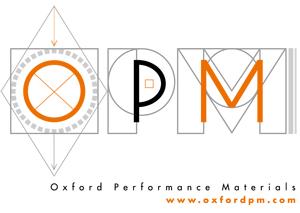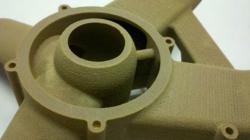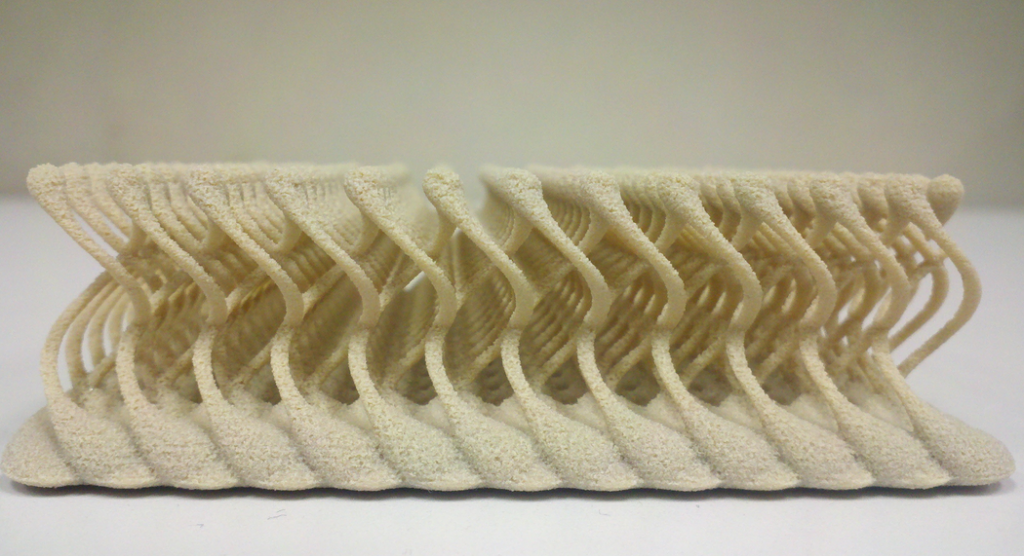Oxford Performance Materials (OPM) has been in the news before for their work with high-tech materials that can be used in 3D printing, especially poly-ether-ketone-ketone (PEKK). Their PEKK (and other) materials find impressive applications in biomedical, aerospace, and industrial markets. Most recently, we reported on a $150,000 grant OPM received last month from the NIH to develop 3D printed medical implants infused with antibiotics.
Today, OPM has announced another step forward in their 3D printing development. With their Biomedical division clearly moving forward, the focus today is on their Aerospace & Industrial division. The first two grades of OPM’s new OXFAB 3D printing material for aerospace and industrial applications launched yesterday, December 10th.
OXFAB, the company’s technology platform, focuses on high-performance solutions at a low cost, based on OPM’s proprietary design algorithm. The goals are to provide the best qualities (strength, flexibility, weight, etc.) to the structural form of designs and create them via SLS technology. OXFAB-N and OXFAB-ESD are PEKK-based materials which utilize OXFAB technology, designed for use in critical applications.
“While additive manufacturing with commodity polymers has been taking place for some time now,” noted Paul Martin, President of OPM Aerospace & Industrial, “this is the first time PEKK is being used for 3D printing in aerospace and industrial applications. Supported by extensive mechanical test data, PEKK is the highest performance thermoplastic available for 3D printing fully functional, end-use parts and components. We are fulfilling critical development contracts for 3D printed parts in a range of applications in commercial and military aircraft, space and industrial products to deliver significant weight and cost savings – a central focus and benefit for our aerospace and industrial customers.”
PEKK is a high-performance polymer that provides some of the most important qualities to critical applications in the aerospace and industrial fields, including resistance to chemicals, high and low temperatures, and radiation; high strength; ultra-low outgassing; and exceptional wear properties. By integrating the OXFAB technology into PEKK materials, OPM is able to create exceptional 3D printed parts for use in strictly regulated applications.
The high-performance capabilities of the two new OXFAB grades seem to be unparalleled. Complex parts can be created using additive manufacturing techniques to capture the exact geometries required, and now can do so utilizing lighter-weight and lower-cost materials than aluminum and composite components manufactured via traditional methods. These thermoplastics are not only cost-competitive, but directly competitive on a performance basis, as noted by Larry Varholak, OPM Aerospace & Industrial’s Vice President of Programs.
“OXFAB’s strength to weight ratio is superior to that of cast aluminum, magnesium and nylon,” Varholak noted. “Due to its inert behavior, OXFAB is highly chemical and heat resistant with the ability to tailor electric properties, which is critical for high-performance aerospace and industrial parts.”
With potential applications within the aerospace industry — e.g., commercial/military aircraft, spacecraft — and in industrial uses — such as in  transportation and semiconductor applications — these products have a wealth of potential.
transportation and semiconductor applications — these products have a wealth of potential.
Of the two grades, OXFAB-N can see good uses in radomes and other unique electrical applications. It is made of PEKK in an unmodified neat form. OXFAB-ESD, on the other hand, is a carbon-filled PEKK material that offers the best potential in more demanding applications due to its excellent mechanical properties.
“We believe that OXFAB will fundamentally improve the way the world’s aircraft and industrial components are manufactured,” said Martin. “OPM’s OXFAB products are ideally suited for end market applications where functional complexity and weight reduction can have a substantial and positive impact on performance, while also yielding cost and energy savings – creating sustained value for our customers.”
These new material introductions sound like another great step forward for OPM’s impressive offerings. Noted as being the first two grades launched, it sounds like we can expect to see more OXFAB technology based on PEKK. This is surely great news for the aerospace and industrial markets, where high performance is not only expected, but a critical requirement. Let us know your thoughts on these new introductions in the OXFAB-N and OXFAB-ESD forum thread over at 3DPB.com.
Subscribe to Our Email Newsletter
Stay up-to-date on all the latest news from the 3D printing industry and receive information and offers from third party vendors.
Print Services
Upload your 3D Models and get them printed quickly and efficiently.
You May Also Like
ASTM International Works with UK MoD on America Makes Project
The UK Ministry of Defense (MoD) will work with ASTM International on a $1.1 million project to let it work in closer concert with the US Department of War (DoW)....
UK Government Funds Research to Develop 3D Printed Metal Alloys for Nuclear Fusion
The UK Atomic Energy Authority (UKAEA), a government-funded research organization, has demonstrated a persistent interest in developing metal additive manufacturing (AM) materials for nuclear fusion applications, including multiple phases of...
Top 10 3DPrint.com Stories of 2025: Kickstarter, Consumer Goods, Bankruptcy, & More
As Vanesa Listek wrote, last year was a major turning point for additive manufacturing (AM), as the industry is working to sort itself out. Customers want proven use cases and...
3D Printing Predictions 2026: Industrial Production & Polymer Additive Manufacturing
Polymer additive manufacturing is seeing less investment, attention, and disruption than metal additive manufacturing currently. Less crucial for defense needs, it has of late had far fewer new entrants. But,...






























